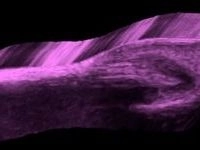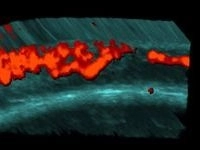By
Ximena Wortsman MD, FAIUM
Chair of the Dermatologic Interest Group and Fellow Member of AIUM (American Institute of Ultrasound in Medicine)
Department of Imaging, Institute for Diagnostic Imaging and Research of the Skin and Sotf Tissues (IDIEP)
Adjunct Associate Professor, Department of Dermatology, Faculty of Medicine, University of Chile, Santiago, Chile
Assistant Professor, Department of Dermatology, Faculty of Medicine, Pontifical Catholic University of Chile
1-Improve surgical planning or medical treatment
Scientific evidence has shown that skin and nail tumors can be better defined with ultrasound in all axes including depth. Moreover, the blood flow within the lesion can be detected in real time. The knowledge of anatomical data may considerably improve the precision of the surgery and may support the decision of the site and size of the incision. The capability to previously know the depth of the lesion may support critical decisions such the performance of a sentinel node procedure or a radiation therapy. Also, sonographic
information may support management decisions in vascular anomalies such as in hemangiomas or vascular malformations.
2-To prevent recurrences
The usage of ultrasound has been described to reduce the possibility of recurrences in nail or skin tumors. Moreover, very few recurrences have been reported in patients that underwent pre-surgical ultrasound examinations. The potential of ultrasound for performing an adequate detection of the depth of the tumor and the potential satellite or in transit metastasis, as well as the involvement of deeper structures can indeed reduce the possibility for failing treatment.
3-Improve cosmetic prognosis
Skin lesions commonly affect highly exposed areas such as the face; therefore, a proper knowledge of the anatomy of the lesional tissue can help to choose the best surgical approach or medical treatment. Furthermore, ultrasound may support a non-invasive follow up of the lesions which can avoid the performance of multiple invasive procedures such as biopsies.
4-To discriminate between a dermatological and non-dermatological origin
Cutaneous swellings or nodules may present an extracutaneous origin and secondarily can involve the skin. These lesions may come from the adjacent structures such as muscles, tendons, glands or bone. The latter findings can be critical in regions where the skin is thin, hence easy to infiltrate. Knowledge of these simulators can orient the treatment properly.
5-To detect activity and severity of a cutaneous disease
It has been reported that ultrasound can detect both activity and severity of common cutaneous diseases such as psoriasis or morphea, and also it is a good indicator of the severity in conditions that could be difficult to manage such as hidradenitis suppurativa. The anatomical data about extension and vascularity are essential to assess the characteristics of these entities.
6-To rule out the presence of exogenous components
Multiple types of foreign components can be found in the skin. These agents may present a traumatic origin, such as pieces of glass or splinters of wood, or may be injected for cosmetic purposes, such
as fillers. The sonographic detection and identification of these components can improve the management of these patients. Furthermore, an ultrasound- guided removal of the foreign bodies may be performed.
7-To avoid as much as possible invasive procedures
Ultrasound can allow the non invasive follow up in common chronic cutaneous diseases and also in the study of ungual conditions which may avoid the need for multiple biopsies. This non invasive study may be especially useful in diseases that affect highly exposed areas such as the face or in regions where biopsies are difficult to perform and may easily generate cosmetic sequels such in the nail.
8-Detect subclinical changes
It has been reported that subclinical lesions can be detected by ultrasound. These conditions include malignant skin tumors such as basal cell carcinoma and also ungual psoriasis. Recognition of subclinical changes may also provide earlier information about the effectiveness of a treatment.
9-Safety and Comfort
Ultrasound does not irradiate such as CT (computed tomography) and does not confine the patient to a reduced space such as MRI (magnetic resonance imaging). The ultrasound examinations allow a
rich interaction between the patient and the sonographer. Moreover, at least in basal studies, ultrasound does not require of the injection of intravenous contrast which prevent the development of adverse reactions.
10-Cost-Effectiveness
The cost of ultrasound examinations is usually lower than the cost of other widely available imaging techniques. Moreover, there would be significant cost savings when both early diagnosis and cosmetic prognosis may be improved and recurrences rates can be decreased. Furthermore, variable frequency ultrasound provides a good balance between resolution and penetration, being capable to measure
submillimeter structures and at the same time detect the involvement of deeper organs without losing definition. All these characteristics provide a wide range of conditions for working in ultrasound in
dermatology.
References
1- Wortsman X, Wortsman J, Clinical usefulness of variable frequency ultrasound in localized lesions of the skin. J Am Acad Dermatol 2010; 62 : 247-256
2- Jasaitiene D, Valiukeviciene S, Linkeviciute G, Raisutis R, Jasiuniene E, Kazys R. Principles of high-frequency ultrasonography for investigation of skin pathology. J Eur Acad Dermatol Venereol.
2011 ;25:375-382.
3-Wortsman X, Wortsman J, Soto R, Saavedra T, Honeyman J, Sazunic I, Corredoira Y. Benign tumors and pseudotumors of the nail: a novel application of sonography. J Ultrasound Med. 2010 ;29:803-816
4-Gutierrez M, Wortsman X, Filippucci E, De Angelis R, Filosa G, Grassi W, High Resolution High-Frequency Sonography in the Evaluation of Psoriasis: Nail and Skin Involvement. J Ultrasound Med 2009 28: 1569-1574.
5-Wortsman X, Vergara P, Castro A, Saavedra D, Bobadilla F, Sazunic I, Zemelman V, Wortsman J.Ultrasound as predictor of histologic subtypes linked to recurrence in basal cell carcinoma of the skin. J Eur Acad Dermatol Venereol. 2015;29:702-7.
6- Music MM, Hertl K, Kadivec M, Pavlovic MD, Hocevar M. Pre-operative ultrasound with a 12-15 MHz linear probe reliably differentiates between melanoma thicker and thinner than 1 mm. J Eur Acad Dermatol Venereol. 2010;24:1105-1108.
7-Catalano O, Caracò C, Mozzillo N, Siani A. Locoregional spread of cutaneous melanoma: sonography findings. AJR Am J Roentgenol. 2010 ;194:735-745
8-Wortsman X, Jemec GBE. High Frequency Ultrasound for the Assessment of Hidradenitis Suppurativa. Dermatol Surg 2007, 33:1-3
9-Wortsman, X., Moreno, C., Soto, R., Arellano, J., Pezo, C. and Wortsman, J., Ultrasound In-Depth Characterization and Staging of Hidradenitis Suppurativa. Dermatol Surg 2013.;39:1835-1842
10-Wortsman X, Wortsman J, Sazunic I, Carreño L.Activity assessment in morphea using color Doppler ultrasound. J Am Acad Dermatol. 2011 ;65:942-8.
11-Wortsman X, Wortsman J, Orlandi C, Cardenas G, Sazunic I , Jemec GBE. Ultrasound detection and identification of cosmetic fillers in the skin.J Eur Acad Dermatol Venereol. 2012;26:292-301.
12-Wortsman X, Alfageme F, Roustan G, Arias-Santiago S, Martorell A, Catalano O, di Santolo MS, Zarchi K, Bouer M, Gonzalez C, Bard R, Mandava A, Gaitini D. Guidelines for Performing Dermatologic Ultrasound Examinations by the DERMUS Group. J Ultrasound Med. 2016;35:577-80




Комментарии